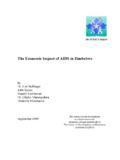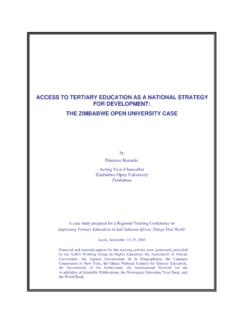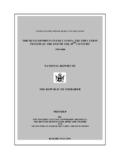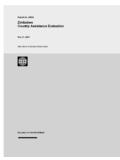Transcription of Manufacturing firms and hyperinflation- survival …
1 Journal of Management and Marketing Research Manufacturing firms and hyperinflation , Page 1 Manufacturing firms and hyperinflation - survival options: the case of zimbabwe manufacturers (2005-2008) Samuel Gumbe University of zimbabwe Nyasha Kaseke University of zimbabwe ABSTRACT The study assesses the survival strategies implemented by Manufacturing firms during hyperinflationary period 2005 to 2008 in zimbabwe . Evidence from literature reviewed indicated that firms can implement different strategies to survive under hyper-inflation environment. Survey method was applied to Manufacturing firms in Harare. Questionnaires were used for data collection from a 100 firms . Survey findings revealed that firms applied different strategies such as quantity reduction, decentralization of decision making, reducing quality of products, development of syndicates, shorter pay periods and other forms of financial, marketing and purchasing strategies.
2 firms which were reluctant in adopting survival strategies collapsed in business. Therefore, survival strategies were of paramount importance for companies in hyper inflationary environments. Keywords: hyperinflation , survival Strategies, Pay Periods, Syndicates, Decentralized decision making, Centralised decision making, Volume reduction Journal of Management and Marketing Research Manufacturing firms and hyperinflation , Page 2 INTRODUCTION The study analyses survival strategies or options implemented by Zimbabwean firms under a hyper inflationary period. A hyperinflationary environment presents huge challenges especially cost control. The last official inflation figures stood at 231 million percent as of July 2008 (Besada and Moyo, 2008).
3 The prices of raw materials generally rose substantially over a very short period of time. In addition, there was no guarantee of supply. Over time there was high probability that customers would begin to resist the frequent price adjustments. A lot of Zimbabwean companies closed down during that period. Some companies managed to continue operating as a result of survival strategies that were employed. Confederation of zimbabwe Industries (CZI) (2007) stated that the Manufacturing sector, which has the responsibility of supplying other downstream Manufacturing industries, tends to bear the brunt of hyperinflation . It further highlights that the Manufacturing sector in zimbabwe is one of the most significant players in the economy due to its contribution to the GDP, export earnings, employment levels and investment opportunities.
4 The objective of this research is to find out what management of these companies did that prevented them from total collapse. Did they implement what other researchers had already discovered, like Eisenhardt and Sull (2001) who recommended that strategy in turbulent environments must be flexible but disciplined. This requires a set of strategic rules to help managers to cope with opportunities and threats without having to refer to superiors. Did managers in zimbabwe take advice of the above recommendations? While some Manufacturing companies succumbed to this harsh economic environment, an increasing number of new-generation companies defied the odds and continued flourishing. BACKGROUND OF ZIMBABWEAN ECONOMY Zimbabwean government inherited a robust economy from the Rhodesian government in 1980 (UNDP, 1992).
5 The country experienced a boom from 1980 to 1981 as shown by high GDP figures of and percent respectively (ibid). These exceptionally high GDP figures could be explained by the opening up of international markets, lifting of the UDI sanctions and a good agricultural season. In 1991 the government embarked on an economic policy; Economic Structural Adjustment Program (ESAP) (Hawkins et al., 1992). Its major objective was for the country to move from an import dependent economy to an open-market economy. The program was also aimed at reforming the monetary policy through the introduction of market determined interest rates. Also, ESAP attempted to liberalize the labour market and to commercialize public enterprises. Due to drought and policy inconsistencies, the benefits of this program were never achieved.
6 ZIMPREST (1996 to 2000) which comes after ESAP was targeted at reducing the budget deficit and the introduction of public sector reforms. It also failed to yield the desired results (Makochekanwa, 2007). The macroeconomic problems during the ZIMPREST era started in 1997 when unbudgeted gratuity payments were made to the veterans (ibid). During the same period, the Zimbabwean dollar (Z$) crushed against all major currencies and the economic situation has never recovered until today. The situation was further worsened when zimbabwe sent troops to the Democratic Republic of the Congo resulting in massive expenditure. These two unbudgeted expenditures contributed to the ballooning of the fiscal deficit (Makochekanwa, 2007). The farm invasions of 2000, prior to the general elections destroyed the once robust agricultural sector as most of the productive white commercial farmers were driven out of the Journal of Management and Marketing Research Manufacturing firms and hyperinflation , Page 3 farms (Besada and Moyo, 2008).
7 The same authors argued that the land distribution was not done transparently and as a result some influential people in the government ended up having multiple farm ownership. They also mentioned that the government dumped the 1998 agreed land reform process and allowed illegal and sometimes violent occupation on farms, and as a result, the donor community terminated their support for the process. These farm invasions as well as the disputed 2000 parliamentary and 2005 presidential elections caused isolation from the international community. Against this background, World Bank announced in October 2000 that it would not extend loans to zimbabwe (ibid). zimbabwe also experienced massive brain drain due to economic meltdown. People migrated all over the world but the greater number to United Kingdom, Australia, Canada and neighboring countries (World Bank, 2008).
8 HIV and AIDS also reduced the number of skilled people who remained in the country (ibid). Further, the local banking sector failed to consistently fund the requirements of the Manufacturing sector (RBZ, 2006). zimbabwe has a huge foreign and domestic debt, isolated from major international funding institutions and low per capita income during the period prior to January 2009 (RBZ, 2009). Hundreds of Zimbabweans died as result of a serious cholera outbreak that has ravaged most urban areas in 2008 (WHO, 2008). This was necessitated by government s failure to provide basic amenities such as clean water and sewerage system. The Manufacturing sector was not an exception to the problem. In addition, the private sector was heavily constrained by severe shortages which included electricity, foreign currency, skilled labour and a shrinking domestic market (The Herald, 2009).
9 THEORETICAL REVIEW - hyperinflation hyperinflation is defined as inflation that is out of control, a condition in which prices increase rapidly as a currency loses its value (Makochekanwa, 2007). He further described hyperinflation as an inflation cycle without any tendency toward equilibrium. Cagan (1956) described hyperinflation as the general increase in prices of goods and services exceeding 50% per month translating into an annual inflation rate of 12,875 percent compounded. Stanlake (1976) states that hyperinflation is an extreme form of inflation were prices rise at a high rate daily. In 1923 Germany experienced this kind of inflation and by the end of that year prices were one million times greater than their pre-war level. Towards the end of 1923, paper money was losing half or more of its value in one hour, and wages were fixed and paid daily.
10 In 1924 the currency was withdrawn and new marks were issued at the rate of 1 Reichsmark = 1 000 000 000 000 old marks. In 1944 Hungary experienced an even more severe inflation, the note circulation reaching a figure with 27 zeros. Under this condition of hyperinflation people lose confidence in the currency s ability to carry out its functions. All the scenarios of daily increases in prices were experienced in zimbabwe and zeros in the currency figures reached 24. This showed hyperinflation as also experienced by other countries. CAUSES OF hyperinflation in zimbabwe The main cause of this hyperinflationary environment in zimbabwe was the massive increase in money supply which was not supported by growth in the output of goods and services (Makochekanwa, 2007).
















